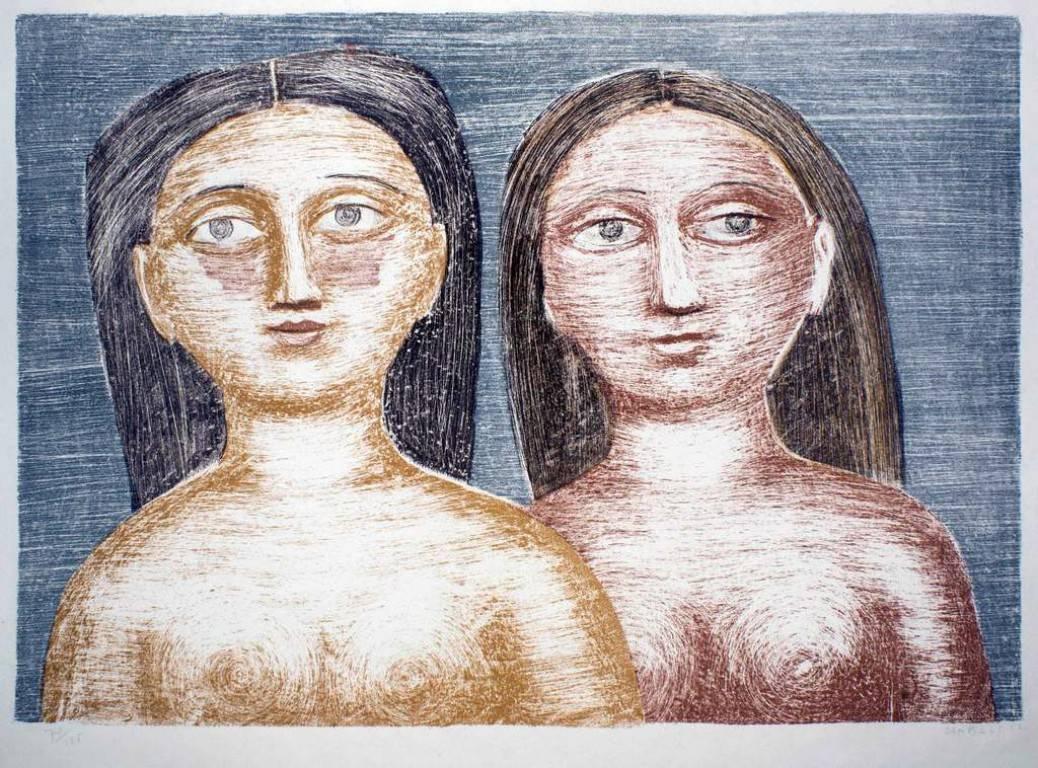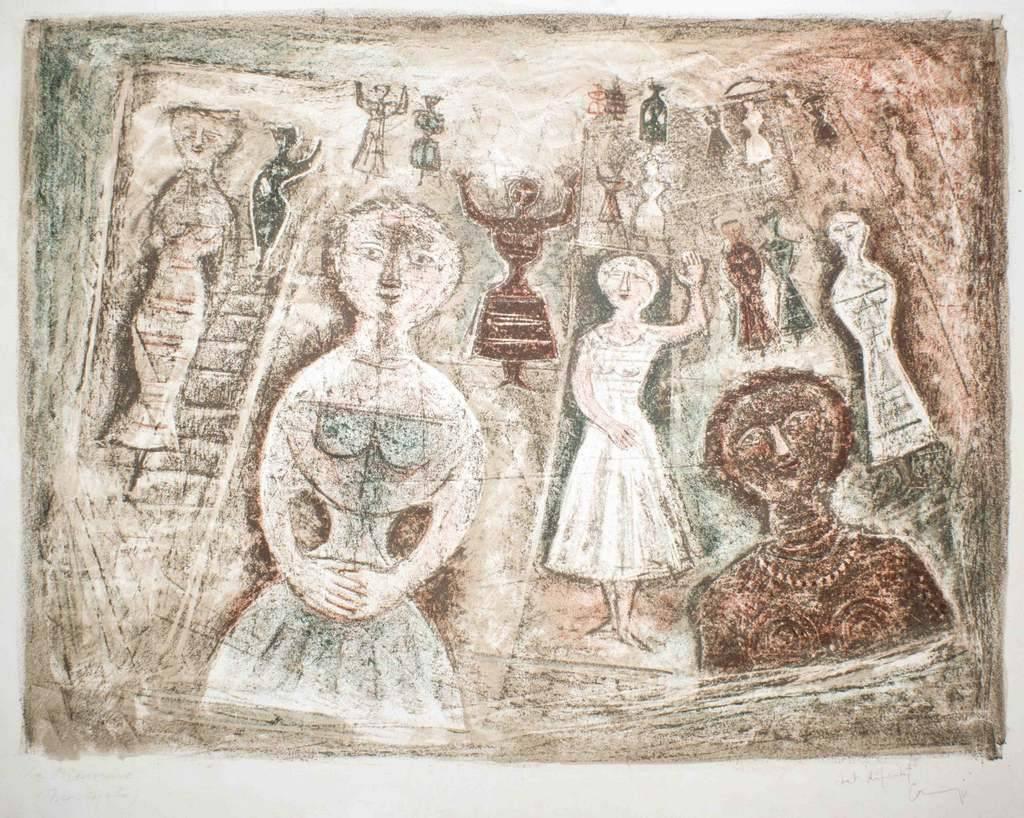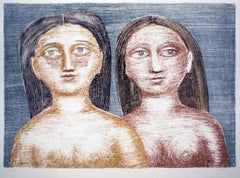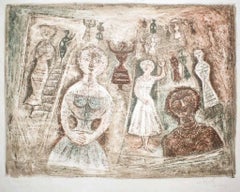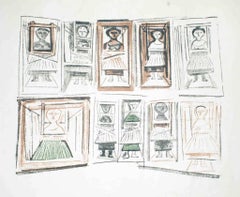Want more images or videos?
Request additional images or videos from the seller
1 of 11
Massimo Campigli, 1895-1971La Collana I1952
1952
$2,500
£1,938.97
€2,197.75
CA$3,577.93
A$3,909.63
CHF 2,026.88
MX$46,706.04
NOK 25,793.29
SEK 24,148.63
DKK 16,411.04
About the Item
This artwork titled "La Collana" is an original color lithograph on Wove paper by renown German/Italian artist Massimo Campigli, 1895-1971. It is hand signed and numbered 46/125 in pencil by the artist. The image size is 14 x 20 inches, framed size is 26.65 x 32 inches. Custom framed in a gold frame, with gold color spacer and fabric matting. It is in excellent condition.
About the artist:
Massimo Campigli, whose real name is Max Hilenfeld (Berlin 4thJuly 1895 – Saint – Tropez 3rdMay 1971), raised up in Italy, where his young mother bring him just after his born in order to avoid a family scandal. He grows up considering the mother as wife, and he will discover the truth only in 1910. This important discovery will have a decisive influence on his way of dealing with the female world. In 1914 Campigli works as secretary for the newspaper Il Corriere della Sera and in the same year he decides to join the war as a volunteer. In 1916 he is taken prisoner in the north of Vienna but he manages to escape and he finally moves to London. From 1919 to 1927 he is correspondent for Corriere della Sera from Paris, the city where he begins to devote himself to painting and where first admires Léger rather than Picasso. He did not have any teacher in his path of artist: he delimits a personal and separated horizon, in a dream of an evocative timeless desire of a boundless ancient imprinting of man, and indeed with all evidence of woman as an archetype.
The world of his childhood, the woman, antiquities and cultures will be the main themes of her painting. Women are his favorite subject, but their sweetness will always be combined with privacy, a refusal or an inability to express themselves.
He participates for the first time in the Salon d’Automne in 1921. Since 1927 he has been able to live with the proceeds of his painting and leaves the position of correspondent for the Corriere della Sera. A few years later travels in central Italy, where he is enchanted by Etruscan art, so much that he denies the works painted in previous years, which he himself defines as "contradictory attempts".
In his painting post cubism takes over a lyrical sentiment now subject only to a slow and constant evolution, indifferent to schools and fashions. In 1928 he is invited to the Biennale di Venezia with a personal room; and he exposes to all editions between 1938 and 1948.
He exhibited in the main international museums in Leipzig, Paris, Madrid, Moscow and New York. He participates in various editions of the Triennale di Milano and the Quadriennale di Roma. Between 1939-40 he reaIized in Padua a monumental decoration (more than 250 square meters) inside the Liviano Palace, reminiscent of the Renaissance pictorial cycles that celebrates the historian Tito Livio. He returns to Paris in 1949 where he was already recognized as one of the best contemporary Italian painters.
He is invited to participate in the great exhibition of Italian art of the twentieth century in New York, organized by Alfred H. Barr and James Thrall Soby at the Museum of Modern Art.
In these years a change takes place in his painting: it is the coherent evolution of a path directed towards the essence of the figurative form, to the research of the archetype.
Since 1967 the artist divides his time between Rome and Saint-Tropez, where he dies on May 31, 1971.
Campigli's works are present in various museums around the world including the Hermitage Museum in Saint Petersburg, Stedelijk Museum in Amsterdam, Musée national d'Art Moderne Center Pompidou in Paris, MOMA in New York, Ikeda Museum of 20th Century Art in Shizuoka, Bellas Artes museum in Bilbao, Vatican Museums, Vatican City.
- Creator:Massimo Campigli, 1895-1971 (1895-1971, Italian)
- Creation Year:1952
- Dimensions:Height: 26.65 in (67.7 cm)Width: 32 in (81.28 cm)Depth: 1.35 in (3.43 cm)
- Medium:
- Movement & Style:
- Period:
- Condition:
- Gallery Location:San Francisco, CA
- Reference Number:Seller: cam/col/011stDibs: LU66638465552
About the Seller
5.0
Platinum Seller
Premium sellers with a 4.7+ rating and 24-hour response times
Established in 1999
1stDibs seller since 2017
858 sales on 1stDibs
Typical response time: 1 hour
- ShippingRetrieving quote...Shipping from: San Francisco, CA
- Return Policy
More From This Seller
View AllLa Collana II
By Massimo Campigli, 1895-1971
Located in San Francisco, CA
This artwork titled "La Collana II" 1952, is an original color lithograph on Wove paper by renown German/Italian artist Massimo Campigli, 1895-1971. It is hand signed and numbered 15...
Category
Mid-20th Century Modern Figurative Prints
Materials
Lithograph
Le Passeggiatrici
By Massimo Campigli, 1895-1971
Located in San Francisco, CA
This artwork titled "Le Passeggiatrici" 1957, is an original color lithograph on Wove paper by renown German/Italian artist Massimo Campigli, 1895-1971. It is hand signed and numbere...
Category
Mid-20th Century Modern Figurative Prints
Materials
Lithograph
Le Bagnanti
By Massimo Campigli, 1895-1971
Located in San Francisco, CA
This artwork titled "Le Bagnanti" 1955 is an original color lithograph on Wove paper by renown German/Italian artist Massimo Campigli, 1895-1971. It is hand signed and numbered 128/1...
Category
Mid-20th Century Modern Figurative Prints
Materials
Lithograph
Torso de Mujer
By Rufino Tamayo
Located in San Francisco, CA
This artwork titled "Torso de Mujer (Torso de Femmee)" from the suite "The Mujeres File" 1969 is an original colors lithograph on Wove paper by renown Mexican artist Rufino Tamayo, 1899-1991. It is hand signed and inscribed H.C. (Hors Commerce) in pencil by the artist. The image size is 26.85 x 21 inches, framed size is 40.75 x 33 inches. Published by Touchtone Publisher, New York, printed by Ateliers Desjobert, Paris. Referenced and pictured in the artist's catalogue raisonne by Pereda, plate #108 page 107. Custom framed in a wooden gold frame, with gold bevel and light beige fabric matting. It is in excellent condition.
About the artist:
A native of Oaxaca in Southern Mexico, Rufino Tamayo's father was a shoemaker, and his mother a seamstress. Some accounts state that he was descended from Zapotec Indians, but he was actually 'mestizo' - of mixed indigenous/European ancestry. (Santa Barbara Museum of Art). He began painting at age 11. Orphaned at the age of 12, Tamayo moved to Mexico City, where he was raised by his maternal aunt who owned a wholesale fruit business.
In 1917, he entered the San Carlos Academy of Fine Arts, but left soon after to pursue independent study. Four years later, Tamayo was appointed the head designer of the department of ethnographic drawings at the National Museum of Archaeology in Mexico City. There he was surrounded by pre-Colombian objects, an aesthetic inspiration that would play a pivotal role in his life. In his own work, Tamayo integrated the forms and tones of pre-Columbian ceramics...
Category
Mid-20th Century Modern Figurative Prints
Materials
Lithograph
Mascara Roja
By Rufino Tamayo
Located in San Francisco, CA
This artwork titled "Mascara Roja" 1969 is an original colors lithograph on B.F.K. Rives paper by renown Mexican artist Rufino Tamayo, 1899-1991. It is hand signed and inscribed H.C. (Hors Commerce) in pencil by the artist. The image size is 21 x 27.25 inches, framed size is 37.25 x 42 inches. Published by Touchtone Publisher, New York, printed by Ateliers Desjobert, Paris. Referenced and pictured in the artist's catalogue raisonne by Pereda, plate #124. Custom framed in a wooden gold leaf frame, with gold and red spacer and fabric matting. It is in excellent condition.
About the artist:
A native of Oaxaca in Southern Mexico, Rufino Tamayo's father was a shoemaker, and his mother a seamstress. Some accounts state that he was descended from Zapotec Indians, but he was actually 'mestizo' - of mixed indigenous/European ancestry. (Santa Barbara Museum of Art). He began painting at age 11. Orphaned at the age of 12, Tamayo moved to Mexico City, where he was raised by his maternal aunt who owned a wholesale fruit business.
In 1917, he entered the San Carlos Academy of Fine Arts, but left soon after to pursue independent study. Four years later, Tamayo was appointed the head designer of the department of ethnographic drawings at the National Museum of Archaeology in Mexico City. There he was surrounded by pre-Colombian objects, an aesthetic inspiration that would play a pivotal role in his life. In his own work, Tamayo integrated the forms and tones of pre-Columbian ceramics into his early still lives and portraits of Mexican men and women.
In the early 1920s he also taught art classes in Mexico City's public schools. Despite his involvement in Mexican history, he did not subscribe to the idea of art as nationalistic propaganda. Modern Mexican art at that time was dominated by 'The Three Great Ones' : Diego Rivera, Jose Clemente Orozco, and David Alfaro Siqueros, but Tamayo began to be noted as someone 'new' and different' for his blending of the aesthetics of post Revolutionary Mexico with the vanguard artists of Europe and the United States.
After the Mexican Revolution, he focused on creating his own identity in his work, expressing what he thought was the traditional Mexico, and refusing to follow the political trends of his contemporary artists. This caused some to see him as a 'traitor' to the political cause, and he felt it difficult to freely express himself in his art. As a result, he decided to leave Mexico in 1926 and move to New York, along with his friend, the composer Carlos Chavez. The first exhibition of Tamayo's work in the United States was held at the Weyhe Gallery, New York, in that same year. The show was successful, and Tamayo was praised for his 'authentic' status as a Mexican of 'indigenous heritage', and for his internationally appealing Modernist aesthetic. (Santa Barbara Museum of Art).
Throughout the late thirties and early forties New York's Valentine Gallery gave him shows. For nine years, beginning in 1938, he taught at the Dalton School in New York.
In 1929, some health problems led him to return to Mexico for treatment. While there he took a series of teaching jobs. During this period he became romantically involved with the artist Maria Izquierdo...
Category
Mid-20th Century Modern Figurative Prints
Materials
Lithograph
La Negra (The Black Woman)
By Rufino Tamayo
Located in San Francisco, CA
This artwork titled "La Negra (The Black Woman)" from the suite "The Mujeres File" 1969 is an original colors lithograph on B.F.K. Rives paper by renown Mexican artist Rufino Tamayo, 1899-1991. It is hand signed and numbered 150/150 in pencil by the artist. The image size is 26.85 x 21.25 inches, sheet size is 29.5 x 22.15 inches, framed size is 42 x 35 inches. Published by Touchtone Publisher, New York, printed by Ateliers Desjobert, Paris. Referenced and pictured in the artist's catalogue raisonne by Pereda, plate #109 page 107. Custom framed in a wooden silver frame, with silver spacer and fabric matting. It is in excellent condition.
About the artist:
A native of Oaxaca in Southern Mexico, Rufino Tamayo's father was a shoemaker, and his mother a seamstress. Some accounts state that he was descended from Zapotec Indians, but he was actually 'mestizo' - of mixed indigenous/European ancestry. (Santa Barbara Museum of Art). He began painting at age 11. Orphaned at the age of 12, Tamayo moved to Mexico City, where he was raised by his maternal aunt who owned a wholesale fruit business.
In 1917, he entered the San Carlos Academy of Fine Arts, but left soon after to pursue independent study. Four years later, Tamayo was appointed the head designer of the department of ethnographic drawings at the National Museum of Archaeology in Mexico City. There he was surrounded by pre-Colombian objects, an aesthetic inspiration that would play a pivotal role in his life. In his own work, Tamayo integrated the forms and tones of pre-Columbian ceramics into his early still lives and portraits of Mexican men and women.
In the early 1920s he also taught art classes in Mexico City's public schools. Despite his involvement in Mexican history, he did not subscribe to the idea of art as nationalistic propaganda. Modern Mexican art at that time was dominated by 'The Three Great Ones' : Diego Rivera, Jose Clemente Orozco, and David Alfaro Siqueros, but Tamayo began to be noted as someone 'new' and different' for his blending of the aesthetics of post Revolutionary Mexico with the vanguard artists of Europe and the United States.
After the Mexican Revolution, he focused on creating his own identity in his work, expressing what he thought was the traditional Mexico, and refusing to follow the political trends of his contemporary artists. This caused some to see him as a 'traitor' to the political cause, and he felt it difficult to freely express himself in his art. As a result, he decided to leave Mexico in 1926 and move to New York, along with his friend, the composer Carlos Chavez. The first exhibition of Tamayo's work in the United States was held at the Weyhe Gallery, New York, in that same year. The show was successful, and Tamayo was praised for his 'authentic' status as a Mexican of 'indigenous heritage', and for his internationally appealing Modernist aesthetic. (Santa Barbara Museum of Art).
Throughout the late thirties and early forties New York's Valentine Gallery gave him shows. For nine years, beginning in 1938, he taught at the Dalton School in New York.
In 1929, some health problems led him to return to Mexico for treatment. While there he took a series of teaching jobs. During this period he became romantically involved with the artist Maria Izquierdo...
Category
Mid-20th Century Modern Figurative Prints
Materials
Lithograph
You May Also Like
Due Nudi
By Massimo Campigli, 1895-1971
Located in Roma, IT
Hand signed. Edition of 125 prints.
Image Dimensions : 33.5 x 48 cm
Category
1950s Modern Figurative Prints
Materials
Lithograph
La Benvenuta
By Massimo Campigli, 1895-1971
Located in Roma, IT
Hand signed and titled.
In 1970 ca., Massimo Campigli realized this fascinating lithograph called “La Benvenuta” (“The Welcome”). Different women are the protagonists of this composi...
Category
1970s Modern Figurative Prints
Materials
Lithograph
Due Nudi - Original Lithograph by M. Campigli - 1952
By Massimo Campigli, 1895-1971
Located in Roma, IT
Hand signed. Edition of 125 prints.
Image Dimensions: 33.5 x 48 cm
Category
1950s Modern Figurative Prints
Materials
Lithograph
Le Tessitrici
By Massimo Campigli, 1895-1971
Located in Roma, IT
Hand signed. Edition of 125 prints.
In “Le Tessitrici” (“The Weavers”), a lithograph dated 1952, the Italian artist multiplies the figures of the weaver, by creating a composition of...
Category
1950s Modern Figurative Prints
Materials
Lithograph
Le Belle di Sera - Lithograph by Massimo Campigli - 1967
By Massimo Campigli, 1895-1971
Located in Roma, IT
Hand signed. Artist's Proof.
“Le Belle di sera” is the title that Massimo Campigli gave to this intense lithograph (1967). The protagonists of this composition are four women that ar...
Category
1960s Modern Abstract Prints
Materials
Lithograph
La Benvenuta - Lithograph by M. Campigli - 1970 ca.
By Massimo Campigli, 1895-1971
Located in Roma, IT
Hand signed and titled.
In 1970 ca., Massimo Campigli realized this fascinating lithograph called “La Benvenuta” (“The Welcome”). Different women are the protagonists of this compos...
Category
1970s Modern Figurative Prints
Materials
Lithograph
More Ways To Browse
Warhol Superman
Warhol Volkswagen
Watercolor Paint Kit Warhol
Whistler Nude Model
Whistler Rotherhithe
Who Stole The Tarts
Will Barnet Season
Will Barnet Woman Reading
Wladimir Sagal
Yiddish Poster
Zita Hastings
George Newman
George Stubbs Painting
Girl And Dog Painting
Golda Meir
Griffith Park
Hair Stick
Henry Takemoto
